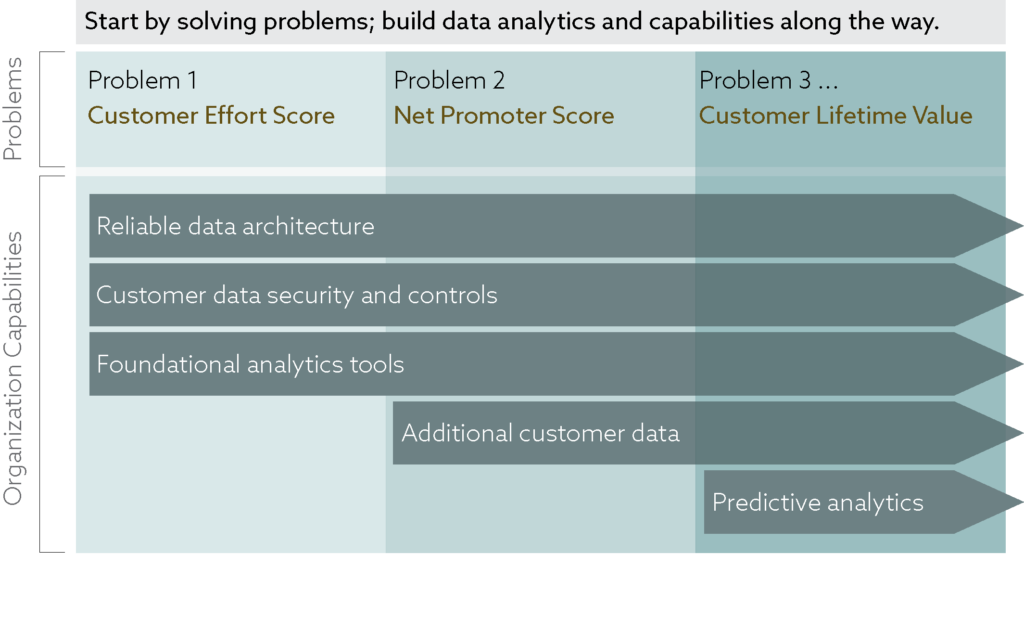Test News
This is a sample news post
Read More
Start by solving problems with tangible business outcomes

Author: Jacob Kirschner
Analytics is at the forefront of today’s complex, highly competitive business environment. We are far past leaders being able to ‘trust their gut.’ Organizations that have mastered applying analytics and data analysis to their decision-making processes have become great competitors. Deep analytics capabilities and business process performance focused on high-impact areas will translate into real business results.
To build your data and analytics capability, start by addressing problems with tangible business outcomes. It’s the surest strategy to gain buy-in and create sustainable success through results.
Too often we see companies start by investing in new high-powered software tools and data-savvy employees with the hope that value and positive business outcomes will spring forth. Not to say this never produces value, but it’s a costly gamble. Why? Data is expensive. Capturing it, storing it, and making sense of it require ongoing investments in people and technology. Without a clear purpose, data architecture, AI, and the like will drain more dollars than they create.
We recommend rallying the data and analytics resources you have at hand to solve a problem that impacts your top or bottom line. Then move on to the next problem and continue to build data, technology, and process capabilities along the way. This way analytics is growing for a purpose. You must still invest in the nuts and bolts that make it all possible – data governance, backend architecture, processing software – but you can be more certain the investment will pay off.
In the most basic sense of the concept, a data analytics framework is a system established or designed by an organization to manage data efficiently and effectively. It’s used in many ways, but to keep it simple, think of it as a perfect union of data processes and technologies. The specific guidelines and solutions may vary, but the ultimate goal is, as we stated above, to derive the greatest value possible for the business problems at hand, from collected data.
It’s used often for:
In order to achieve optimal results from your data analytics framework, consider supporting it with technologies and solutions like cloud trends, hybrid multi-cloud deployment, data integration, data warehouses, storage infrastructure like data lakes, etc.
We’ve expressed the importance of first addressing problems with tangible business outcomes and asking smart questions. Keep these two things in mind as you head into your strategic planning.
[Read More: The Intersection of Data Strategy and Artificial Intelligence]
Let’s say a mid-sized bank wants to make it easier for their customers to do business with them – a major driver of customer loyalty. Their data collection and analytics indicate lagging customer retention rates and pointed qualitative feedback suggests the bank is struggling in this area.
This is a problem with a direct impact on revenue. It’s also an analytics problem. Measuring the Customer Effort Score (CES) and the drivers behind it requires solid backend data architecture, data governance controls, security, and the right technology.
By identifying a specific problem using leveraging their data collection, the bank can better understand how using data to solve this problem will have tangible business outcomes.
A chief technology officer investing in data architecture with the explicit purpose of deriving a CES will get more traction than her counterpart looking to update data architecture for a hypothetical future purpose. While the result is the same – better data architecture – without a clear purpose, the investment is a more difficult sell.
This same bank also needs to know how its customers feel about their business. How likely are they to promote the bank to their friends, family, and social media followers? This metric, Net Promoter Score, is a sure driver of business growth. An analytics leader that works to unpack this metric is contributing directly to top-line revenue. With the foundation in place to measure the CES, the analytics group will have a much easier time adding the new metric.
As successes follow one another, the organization grows organically. Leaders across the business see tangible business results from their data and seek more solutions from analytics capabilities. The culture shifts as profit grows.

This outcomes-based, problem-solving approach requires cross-functional collaboration. Instead of the “build it and they will come” approach favored by some IT departments, growth through problem-solving is, “come on over and let’s build it together.” Analytics. though highly technical, works best when it is a function of the business and IT together and not the sole purview of one or the other. If the only interaction between a business and its analytics group is an intake request form for a new management report, data is not driving much value.
By seeking out and solving problems, and starting data solutions by identifying problems, analytics leadership is engaging with business leaders on a more meaningful level. Conversations and workshops between leadership and the analytics team build understanding and help create confidence in the data, the processes, and the people. Business leaders who trust the data are more likely to use it in making key decisions and research shows that leads to better decisions.
 Jacob Kirschner is a senior consultant at RevGen Partners. He is passionate about helping clients solve problems through data and analytics.
Jacob Kirschner is a senior consultant at RevGen Partners. He is passionate about helping clients solve problems through data and analytics.
Get the latest updates and Insights from RevGen delivered straight to your inbox.